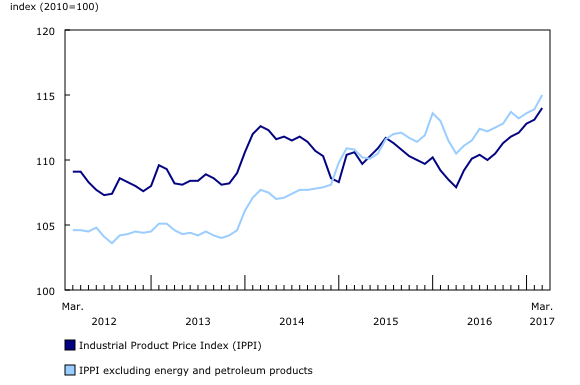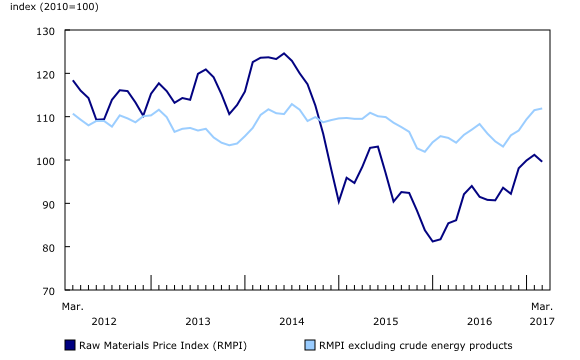Industrial product and raw materials price indexes, March 2017
Archived Content
Information identified as archived is provided for reference, research or recordkeeping purposes. It is not subject to the Government of Canada Web Standards and has not been altered or updated since it was archived. Please "contact us" to request a format other than those available.
Released: 2017-04-28
The Industrial Product Price Index (IPPI) rose 0.8% in March, mainly due to higher prices for motorized and recreational vehicles and primary non-ferrous metal products. The Raw Materials Price Index (RMPI) decreased 1.6%, primarily due to lower prices for crude energy products.
Industrial Product Price Index, monthly change
The IPPI (+0.8%) increased for a seventh consecutive month in March, following a 0.3% gain in February. This was the largest increase since June 2016. Of the 21 major commodity groups, 20 were up and 1 was down.
The growth in the IPPI was largely attributable to higher prices for motorized and recreational vehicles (+1.2%) and primary non-ferrous metal products (+2.0%).
Higher prices for passenger cars and light trucks (+1.2%), motor vehicle engines and motor vehicle parts (+1.1%) and aircraft (+2.2%) were mainly responsible for the increase in the motorized and recreational vehicles product group. Higher prices for motorized and recreational vehicles were closely linked to the depreciation of the Canadian dollar relative to the US dollar.
The increase in the primary non-ferrous metal products group (+2.0%) was largely attributable to higher prices for unwrought precious metals and precious metal alloys (+2.0%) and unwrought aluminum and aluminum alloys (+5.5%).
Chemicals and chemical products (+1.2%) also contributed to the increase in the IPPI. Higher prices for petrochemicals (+4.1%) and chemical products, not elsewhere classified (+3.5%) were the main reasons for the growth in this commodity group.
Higher prices for pulp and paper products (+1.9%) also contributed to the increase in the IPPI, but to a lesser extent. The increase in this product group was mainly due to higher prices for wood pulp (+3.7%).
The growth in the IPPI was moderated by a decline in energy and petroleum products (-0.3%). Lower prices for lubricants and other petroleum refinery products (-3.9%), diesel fuel (-1.7%) and light fuel oils (-1.4%) were the main contributors to the decline. Higher prices for heavy fuel oils (+5.5%) and asphalt (other than natural) and asphalt products (+4.2%) moderated the decline in the energy and petroleum products group. The IPPI excluding energy and petroleum products rose 1.0%.
Some IPPI prices are reported in US dollars and converted to Canadian dollars using the average monthly exchange rate. Consequently, any change in the value of the Canadian dollar relative to the US dollar will affect the level of the index. From February to March, the Canadian dollar depreciated 2.1% relative to the US dollar. If the exchange rate had remained constant, the IPPI would have advanced 0.3% instead of 0.8%.
Industrial Product Price Index, 12-month change
The IPPI rose 5.1% over the 12-month period ending in March, after increasing 3.6% in February. This was the largest year-over-year increase since November 2011 (+6.0%).
The year-over-year increase in the IPPI was mostly attributable to higher prices for energy and petroleum products (+20.0%). Motor gasoline (+16.1%), light fuel oil (+26.1%), diesel fuel (+20.0%) and heavy fuel oils (+56.9%) were the primary contributors to the rise in this commodity group. Year over year, the IPPI excluding energy and petroleum products was up 3.1%.
Compared with March 2016, primary non-ferrous metal products (+11.6%) also contributed to the increase in the IPPI, albeit to a lesser extent. Higher prices for other unwrought non-ferrous metals and non-ferrous metal alloys (+35.2%) led the gain in this commodity group. Unwrought precious metals and precious metal alloys (+5.3%), unwrought aluminum and aluminum alloys (+17.1%) and unwrought copper and copper alloys (+20.0%) were also up compared to the same month a year earlier.
Year over year, chemicals and chemical products rose 7.5%, primarily due to higher prices for petrochemicals (+36.1%), particularly aromatic hydrocarbon gases (+40.9%) and liquefied refinery gases, and acyclic hydrocarbons not elsewhere classified (+49.8%). Prices for basic chemicals (+5.9%) and fertilizers, pesticides and other chemical products (+3.4%) also exerted upward pressure on this group.
Primary ferrous metal products (+10.1%) also rose compared with March 2016. The increase in this commodity group was mainly attributable to higher prices for wire and other rolled and drawn steel products (+23.9%) and iron and steel basic shapes (+7.2%).

In celebration of the country's 150th birthday, Statistics Canada is presenting snapshots from our rich statistical history.
Following a period of significant inflation during the First World War and the years immediately following, Canadian producer prices began falling in 1921. This initiated a period of deflation that extended into the Great Depression. From 1920 to 1932, the price that Canadian goods producers received for their products, as measured by the General Wholesale Price Index, decreased by 57%. In 1932, prices were at their lowest levels since 1914.
The largest price declines from 1920 to 1932 were for vegetable products (-67%), fibres, textiles and textile products (-61%), animals and their products (-59%), nonferrous metals and their products (excluding gold) (-56%) and wood, wood products, and paper (-55%).
Raw Materials Price Index, monthly change
The RMPI was down 1.6% in March, following a 1.3% increase in February. This was the largest decline in the RMPI since July 2016 (-2.7%). Of the six major commodity groups, three were down and three were up.
The decrease in the RMPI was primarily due to lower prices for crude energy products (-4.3%). The decline in this product group was mainly attributable to lower prices for conventional crude oil (-4.4%). This was the first decline in conventional crude oil since November 2016 (-7.4%). The RMPI excluding crude energy products rose 0.4%.
The decline in the RMPI was primarily moderated by higher prices for animals and animal products (+1.2%), specifically cattle and calves (+5.9%). Lower prices for hogs (-2.1%) moderated the increase in the animals and animal products group.
Prices for metal ores, concentrates and scrap also rose in March (+0.6%). The increase in this commodity group was mainly due to higher prices for waste and scrap of metal (+2.5%).
Raw Materials Price Index, 12-month change
The RMPI rose 16.6% in the 12-month period ending in March, following a 23.9% increase in February.
Compared with March 2016, the increase in the RMPI was largely due to higher prices for crude energy products (+34.4%), primarily conventional crude oil (+36.5%). The RMPI excluding crude energy products rose 6.5%.
Year over year, prices for metal ores, concentrates and scrap (+15.0%) also rose, following a 15.3% gain in February.
The logs, pulpwood, natural rubber and other forestry products group (+11.5%) also contributed to the year-over-year gain in the RMPI, to a lesser extent.
Note to readers
Starting with the collection of February 2017 data, the Industrial Product Price Index (IPPI) and Raw Materials Price Index (RMPI) program changed its data collection mode from a paper questionnaire to an electronic questionnaire. The redesigned questionnaire collects additional information on product classification or NAPCS (North American Product Classification System), geography, product characteristics, selling or purchase price, reasons for price change as well as revenue and expenditure data.
The IPPI and RMPI are available at the Canada level only. Selected commodity groups within the IPPI are also available by region.
With each release, data for the previous six months may have been revised. The indexes are not seasonally adjusted.
The Industrial Product Price Index reflects the prices that producers in Canada receive as the goods leave the plant gate. It does not reflect what the consumer pays. Unlike the Consumer Price Index, the IPPI excludes indirect taxes and all the costs that occur between the time a good leaves the plant and the time the final user takes possession of it, including transportation, wholesale and retail costs.
Canadian producers export many goods. They often indicate their prices in foreign currencies, especially in US dollars, which are then converted into Canadian dollars. In particular, this is the case for motor vehicles, pulp, paper and wood products. Therefore, a rise or fall in the value of the Canadian dollar against its US counterpart affects the IPPI. However, the conversion into Canadian dollars only reflects how respondents provide their prices. This is not a measure that takes the full effect of exchange rates into account.
The conversion of prices received in US dollars is based on the average monthly exchange rate (noon spot rate) established by the Bank of Canada and available in CANSIM table 176-0064 (series v37426). Monthly and annual variations in the exchange rate, as described in the release, are calculated according to the indirect quotation of the exchange rate (for example, CAN$1 = US$X).
The Raw Materials Price Index reflects the prices paid by Canadian manufacturers for key raw materials. Many of those prices are set on the world market. However, as few prices are denominated in foreign currencies, their conversion into Canadian dollars has only a minor effect on the calculation of the RMPI.
Infographic: Producer Price Indexes at a Glance
The infographic "Producer Price Indexes at a Glance," which is part of Statistics Canada — Infographics (11-627-M), demonstrates how producer price indexes for goods and services are calculated and why they are important for the Canadian economy.
Real-time CANSIM tables
Real-time CANSIM table 329-8074 will be updated on May 8. For more information, consult the document Real-time CANSIM tables.
Next release
The industrial product and raw materials price indexes for April will be released on May 30.
Contact information
For more information, or to enquire about the concepts, methods or data quality of this release, contact us (toll-free 1-800-263-1136; 514-283-8300; STATCAN.infostats-infostats.STATCAN@canada.ca) or Media Relations (613-951-4636; STATCAN.mediahotline-ligneinfomedias.STATCAN@canada.ca).
- Date modified:





